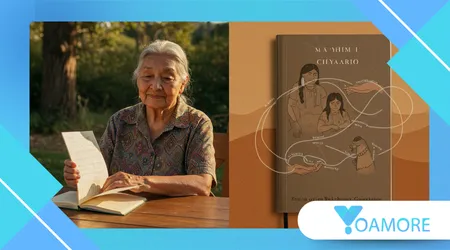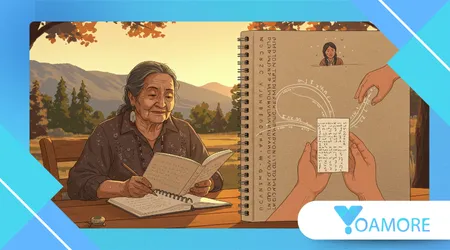Wukchumni and the Woman Who Wrote a Dictionary to Save It

The Wukchumni language, a dialect of Tule-Kaweah Yokuts, stands as a profound testament to the power of a single individual’s dedication.
Anúncios
What happens when a language teeters on the brink of extinction? A remarkable story unfolds, one of an elder, her family, and a dictionary crafted from memory and a deep love for her culture.
The following text explores this monumental effort to preserve a language, the importance of linguistic diversity, and the enduring legacy of Marie Wilcox.
We will explore the challenges faced, the incredible accomplishments, and what the future holds for the Wukchumni language.
A Legacy of Words and Will
A language isn’t just a collection of sounds; it’s the very soul of a people. It holds their history, their stories, and their unique way of understanding the world around them.
Anúncios
When a language fades, it’s like a library burning down, a loss that can never be fully recovered.
Marie Wilcox understood this truth with her entire being. She wasn’t just compiling a dictionary; she was building an ark to carry her people’s identity into the future.
Her work ensures that the Wukchumni language doesn’t just become a footnote in history books.
For more than two decades, Marie Wilcox, the last fluent speaker of Wukchumni, painstakingly worked to save her language. She started with a simple spiral notebook and a desire to pass on what she knew.
It was a race against time, a solitary act of defiance against the forces of assimilation and silence.
She had no formal training in linguistics, only the profound knowledge of her ancestors flowing through her veins. This task became her life’s work.
The Power of Memory and Persistence

Imagine trying to write a dictionary for a language that exists almost entirely in your head. It’s like trying to rebuild a magnificent, intricate stained-glass window from memory.
Marie’s dictionary is a monumental achievement born of sheer will. She collaborated with her daughter, Jennifer Malone, and other family members, capturing words, phrases, and stories.
The project was a beautiful, intergenerational conversation.
This labor of love resulted in a 995-page dictionary, a stunning achievement. It’s an invaluable resource for her tribe and for future generations.
The dictionary includes pronunciations and historical context for many words. It’s not a mere list but a guide to a complete worldview.
Her family also recorded an audio version of the dictionary to preserve the sound of the language.
+ The Phantom Time Hypothesis: Did 300 Years Never Happen?
A Beacon of Hope for Indigenous Languages
The Wukchumni language preservation effort highlights a global crisis. The United Nations reports that an indigenous language dies every two weeks.
This alarming statistic underscores the urgency of efforts like Marie Wilcox’s. Her project is a shining example for other communities facing similar linguistic endangerment.
Her work demonstrates that it’s possible to reverse this trend.
Furthermore, her dedication has inspired many others, showing that language revitalization is a human-powered effort.
It’s about community, family, and fierce love. It’s a testament to the fact that you don’t need a PhD in linguistics.
You simply require a deep-seated belief in the value of your heritage. The Wukchumni dictionary has become a symbol of hope.
Her work has attracted global attention, including a powerful documentary film. “Marie’s Dictionary” beautifully captures her spirit and mission.
The documentary shows her process and the love that fuels it. It serves as an accessible and moving introduction to this story. You can watch “Marie’s Dictionary” to see her incredible work firsthand.
The Domino Effect of a Single Act
A single act of courage can have a ripple effect far beyond its initial scope. Marie’s dictionary sparked a language revitalization movement.
It’s a domino effect, where one person’s dedication inspires many others. The dictionary is now the cornerstone of language classes for tribal members.
The work didn’t end with the completion of the dictionary. It was just the beginning. The next step was teaching the language to the younger generations.
Marie, along with her daughter, began offering classes to share the knowledge. They taught beginners and those who had some prior exposure. This passing of the torch is crucial.
The Wukchumni tribe now has multiple fluent speakers. This impressive feat is a direct result of Marie’s work. It demonstrates that a language can be brought back from the edge.
As of 2021, at least three people are fluent, a remarkable turnaround. It is a testament to the power of one.
+ Endangered Sign Languages: The Case of Al-Sayyid Bedouin Sign Language
The Cultural Context of Language
Language is not just grammar and vocabulary; it’s culture. The Wukchumni language contains stories, parables, and a deep connection to their ancestral lands.
The vocabulary reflects a specific relationship with the environment. It reveals an understanding of plants and animals. The language is a living map.
It also contains the nuances of social interaction and traditional knowledge. A phrase in Wukchumni might hold a deeper meaning or a historical reference.
It is a way of seeing the world that cannot be perfectly translated. Losing this means losing a piece of a community’s soul. Preserving it means keeping those ties alive.
+ Koro: A Language Discovered in the Himalayas.
From One Speaker to the Next Generation
One of the most moving parts of this story involves Marie’s great-granddaughter, Destiny Treglown.
She is raising her child, Oliver, to be a speaker of Wukchumni. If he reaches fluency, he will be the first native speaker in four generations. This is a powerful sign of a cultural rebirth.
It’s an effort that requires incredible commitment and daily practice. They are living the language, not just studying it in a classroom.
This approach is vital for the language to truly survive and thrive. It must be spoken at home, in the family, and in everyday life. The future of Wukchumni is in their hands.
Consider the dedication involved: every day, Destiny makes a conscious choice to speak the language to her child. She is actively creating a future where the language is alive.
This is an incredible and vital commitment. It is not an easy path. It is a conscious rejection of cultural erosion.
The Broader Impact and What We Can Learn
Marie Wilcox’s story is an inspiring example of grassroots activism. It shows that immense change can begin with one person.
It demonstrates the importance of elders and their unique knowledge. They are living libraries, and we must honor them. They are the keepers of invaluable history.
It’s also a powerful lesson in what it means to be a modern human. We live in a world of constant information, but how often do we truly listen?
Marie Wilcox’s story asks us to slow down. It invites us to consider the value of what we are losing. Do we appreciate the languages and cultures that are disappearing?
The table below illustrates the alarming rate of language loss, with a focus on endangered languages in North America.
| Region | Number of Languages | Percentage Severely Endangered or Extinct |
| North America | 239 | 77% |
| South America | 445 | 45% |
| Europe | 201 | 42% |
| Asia | 1,402 | 44% |
| Africa | 2,138 | 13% |
Data based on UNESCO’s Atlas of the World’s Languages in Danger
This data highlights a critical issue. The vast majority of North American indigenous languages are at risk.
The Wukchumni effort stands in stark contrast to this trend. It is a successful story in a sea of loss. It offers a blueprint for how to combat language endangerment.
FAQs
Q1: Is the Wukchumni dictionary available to the public?
A1: Marie Wilcox’s dictionary was copyrighted in 2019 but has not been formally published. It is primarily used as a resource for the Wukchumni tribal community to aid in their language revitalization efforts and classes. The focus is on revitalizing the language within the community before wider distribution.
Q2: How can I support indigenous language preservation?
A2: You can support organizations dedicated to language revitalization. Many indigenous communities have their own cultural preservation programs. You can also research the native languages of your area and learn about the local efforts being made. Learning a few words or phrases is a good start. For example, you can support organizations like the Advocates for Indigenous California Language Survival.
Q3: What happened to Marie Wilcox?
A3: Marie Wilcox passed away in 2021 at the age of 87. Her passing marked a profound loss, but her legacy continues to live on through her dictionary and the revitalized Wukchumni language. Her work ensured that her language would not die with her. Her family and her community continue her work with incredible passion.
